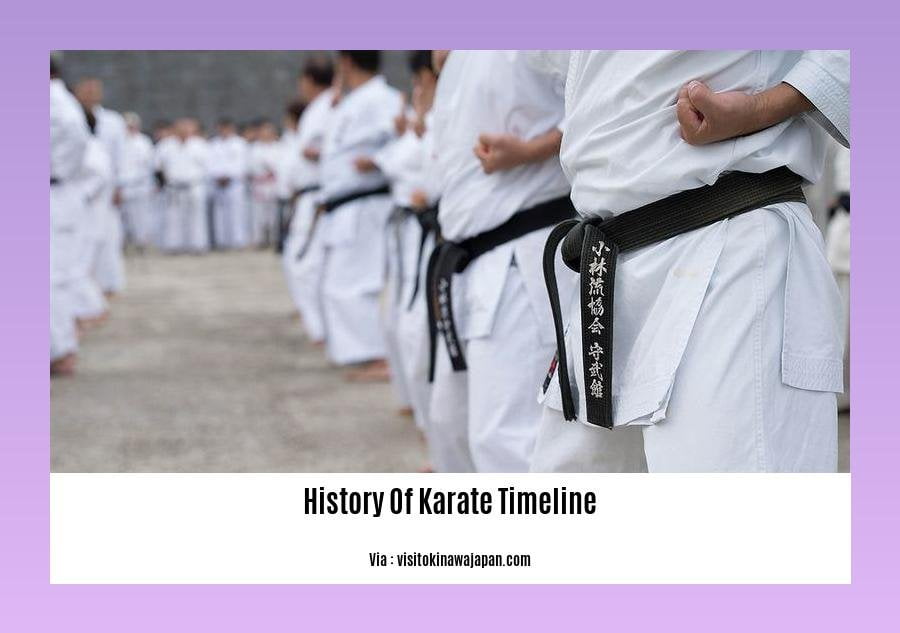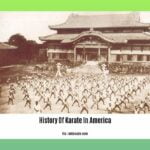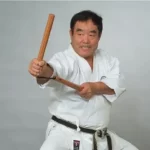Embark on a historical journey through the annals of martial arts with our comprehensive timeline of karate’s evolution. From its humble beginnings in Okinawa to its global proliferation, discover the milestones, figures, and influences that have shaped this revered art form. [History of Karate: A Comprehensive Timeline] unravels the rich tapestry of karate’s past, present, and future.
Key Takeaways:
- Karate originated in East Asia and was systematized in Okinawa in the 17th century.
- The ban on weapons in Okinawa accelerated the development of karate.
- Karate was introduced to Japan in the 1920s, leading to the creation of various schools and systems.
- Notable figures in karate’s history include Gichin Funakoshi, Soshaku Takashima, and Mitsusuke Harada.
- Karate expanded globally, with Shotokai Karate arriving in the UK in 1963 and Wado Ryu Karate in 1964.
History of Karate Timeline
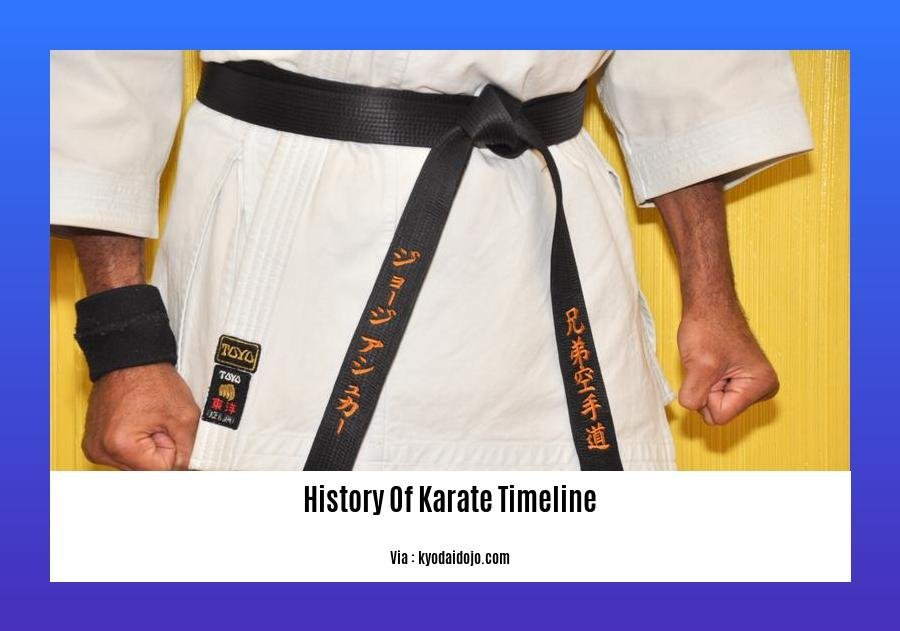
Karate, a martial art that originated in Okinawa, has a rich history spanning centuries. Let’s delve into its intriguing History Of Karate Timeline:
14th Century:
* The roots of karate can be traced back to China, where it developed as a form of unarmed combat.
* Known as “Te” in Okinawa, it was influenced by various Chinese martial arts.
17th Century:
* Okinawa, under Japanese feudal rule, banned the possession of weapons.
* Te practitioners adapted their techniques to use their bodies as weapons.
19th Century:
* Te evolves into a more refined and systematized martial art called “Kara-te” (empty hand).
Early 20th Century:
* Gichin Funakoshi, widely regarded as the father of modern karate, introduced Karate to mainland Japan.
* Kara-te became popular in universities and schools, gaining recognition as a legitimate martial art.
Mid 20th Century:
* Karate was introduced to the West after World War II.
* Various schools and styles emerged, each with its unique characteristics and training methods.
Present Day:
* Karate is practiced worldwide, with millions of practitioners.
* It is recognized as a sport in the Olympics, a symbol of physical and mental discipline.
Karate’s History Of Karate Timeline reveals its remarkable journey from its humble beginnings to becoming a respected martial art and cultural phenomenon.
If you’ve ever wondered about the origins and evolution of this martial art, you might find the history of karate fascinating.
The History of Karate Facts reveals intriguing details about this ancient martial art that originated in Okinawa.
Explore the History of Karate in Japan to uncover how it was introduced and developed within the country.
Learn about the journey of Karate from Okinawa to America by reading about the History of Karate in America.
The History of Karate in Okinawa sheds light on the origins and evolution of this martial art on its home island.
The History of Karate Belts explains the significance and tradition behind the different colored belts worn by karate practitioners.
Development of Different Styles
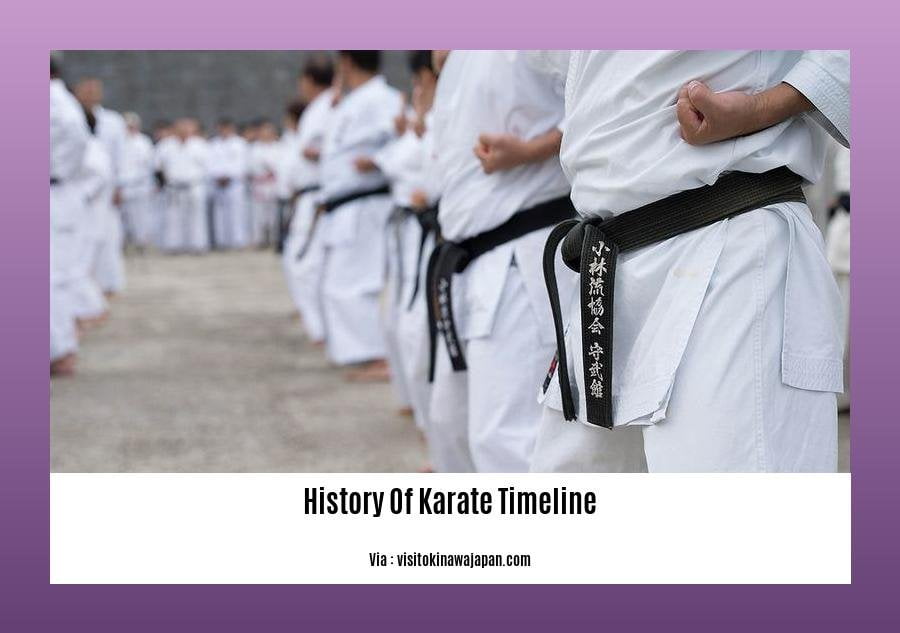
Karate, a martial art steeped in history, began in Okinawa and evolved over centuries. Today, it’s a diverse art with numerous styles.
Genesis in Okinawa
Okinawa’s unique history played a pivotal role in the birth of karate. After 1609, a weapons ban forced locals to adapt. Their existing combat knowledge merged with Chinese influences, resulting in a new fighting art: karate.
Spread and Diversification
In the 20th century, karate began its global journey. Different teachers brought their interpretations, leading to the emergence of distinct styles. Each style retains the core principles of karate yet offers unique characteristics.
Popular Styles
Some of the most prominent karate styles include:
| Style | Origin | Philosophy |
|---|---|---|
| Shotokan | Gichin Funakoshi | Emphasis on athleticism and stances |
| Goju-Ryu | Chojun Miyagi | Focus on circular movements and breathing |
| Kyokushin | Mas Oyama | Known for full-contact sparring and toughness |
| Uechi-Ryu | Kanbun Uechi | Influenced by Chinese boxing techniques |
Key Takeaways:
- Karate originated in Okinawa in the 1600s.
- A weapons ban influenced its development.
- Chinese martial arts contributed to its techniques.
- Different karate styles emerged as the art spread globally.
- Each style has a unique philosophy and approach.
Sources:
Global Dissemination
Karate’s journey beyond its Okinawan birthplace is a fascinating tale of cultural exchange and martial prowess. In the early 20th century, karate’s dissemination to mainland Japan paved the way for its global expansion.
Japanese instructors played a pivotal role in karate’s propagation after World War II. They introduced the art to military personnel and civilians across the globe, fostering a wave of interest that continues to this day.
Key Takeaways:
- Karate’s global dissemination began in mainland Japan.
- Post-war efforts by Japanese instructors facilitated its spread worldwide.
- Karate’s popularity has surged globally, with various styles and schools emerging.
Sources:
– Britannica: Karate
– Rookieroad: History of Karate
Modernization and Innovations
As karate evolved, it underwent significant modernization and innovation. Here’s how the art form adapted and progressed over time:
Emergence of New Styles
During the 20th century, several new karate styles emerged, each with its unique techniques and philosophies. Styles like Shotokan and Wado-ryu drew inspiration from traditional Okinawan forms but introduced modern training methods and competition formats.
Introduction of Protective Gear
In the early days, karate training often involved full-contact sparring without protective gear. As the sport gained popularity, protective gear such as headgear, body armor, and gloves were introduced to minimize injuries and make sparring safer.
Integration of Technology
With advancements in technology, karate training has incorporated modern tools. Video analysis and motion capture systems help students improve their technique by providing detailed feedback and visualizations.
Karate in Popular Culture
Karate’s popularity surged in the West after World War II, thanks to movies and television shows that showcased its dynamic techniques. The emergence of karate in pop culture helped spread awareness and attract a global audience.
Key Takeaways:
- Modernization introduced new styles, training methods, and protective gear.
- Innovation has led to the integration of technology and advancements in training techniques.
- Karate in popular culture has played a significant role in its global dissemination.
Relevant URL Sources:
Karate History and Evolution
The Modernization of Karate
FAQ
Q1: What are the key milestones in the history of karate?
Q2: How did the weapons ban in Okinawa influence the development of karate?
Q3: Who are some of the notable figures in the history of karate?
Q4: How did karate spread from Okinawa to the rest of the world?
Q5: What are the different styles of karate and how did they evolve?
- Mastering Leader in Spanish: The Complete Guide - April 19, 2025
- Uncovering Surprising Parallels: England Size Compared to US States - April 19, 2025
- Old Mexico Map: Border Shifts 1821-1857 - April 19, 2025
